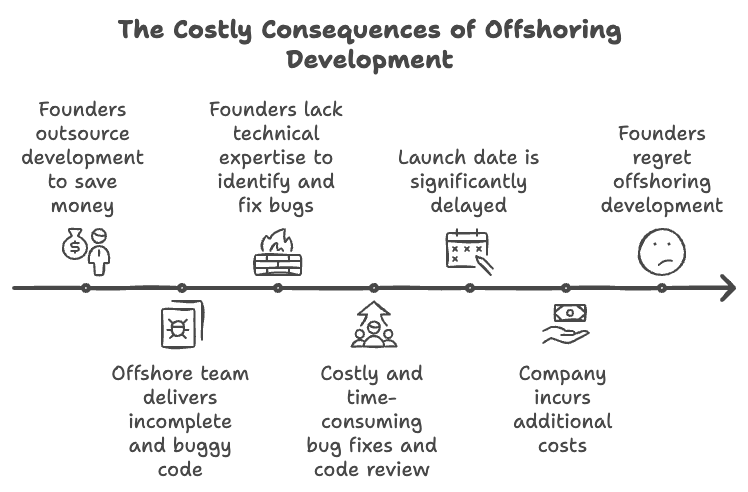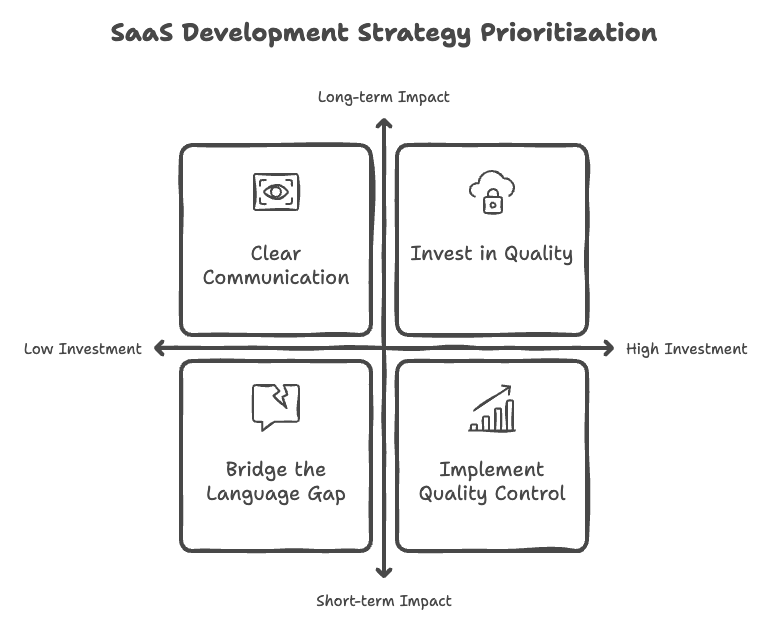Why Many Founders Struggle with Their SaaS Apps and Offshore Teams - The Hidden Pitfalls

Navigating the world of Software as a Service (SaaS) development can be tricky. Many founders, like you, often turn to offshore teams with the hope of cutting costs and speeding up their projects. But is that always the fastest (or cheapest) choice? Unfortunately, this often leads to unexpected challenges that will complicate and sometimes extend the development process.
The Reality Check
At Jetpack Labs we often are called in to work with founders after they’ve already spent significant time and money already building their product with an offshore team. Why, you ask? Well sadly, by the time they “finish” the project with the outsourced team, this only marks the beginning of an incredibly frustrating journey. While the code may look complete, it often times contains time bombs - poorly written code that is not ready for beta, let alone public launch. And with many startup founders lacking the in-house technical expertise to be able to find these bugs prior to offboarding their offshore teams, they’re left holding the bag both financially and schedule-wise. This then kicks off a seemingly never-ending cycle of bug fixes and sorting through low-quality code, often at significant additional cost. Ironically, by being prudent and trying to save money at the outset, you’ve only cost your company more money and significantly delayed your launch date.

A Vision for Success
Contrast this scenario with one where you are confident that your SaaS application isn’t riddled with bugs, isn’t stuck in an endless loop of “fixes” and communication issues. Just like you’d never take your car to a mechanic of ill repute or hire a random stranger to build you a house without references - why would you trust your company’s future to strangers overseas? Quite frequently cheaper overseas development firms outsource the majority of their development work to bottom of the barrel coders fresh from coding “boot camps”. And unfortunately, you get what you pay for.
Prioritize Quality
To empower your SaaS venture, start by recognizing that the allure of quick turnarounds at low costs will almost always compromise quality. As they say in software development: “You can have it fast, you can have it good, you can have it cheap: pick two”. So how do you level up your development?
- Invest in Quality:
Choose development teams that prioritize quality over speed (within reason). While it might seem like a bigger investment upfront, it can save you from frustration and cost overruns down the line. High-quality code isn’t just about functionality; it lays a solid foundation for scalability, maintainability, and security as your user base grows. Think of it like building a house: cutting corners on the foundation may save money now, but the costs of repairs later will far exceed those initial savings. By prioritizing quality from the start, you’re not just aiming for a smooth launch; you’re setting up for long-term success.
- Focus on Communication:
Clear communication is crucial, especially when working with remote or offshore teams. Engaging teams in your time zone or those willing to adapt their hours can reduce friction caused by misaligned schedules. When everyone is aligned, misunderstandings, missed deadlines, and project derailments become less likely. Establish regular check-ins and use collaborative tools everyone is comfortable with. Encourage an environment where questions are welcome, and updates are shared proactively. Documenting discussions can also help ensure everyone has access to the same information. Transparency is KEY!
- Bridge the Language Gap:
Language barriers can lead to miscommunication with offshore teams. It’s essential to articulate your vision clearly. A well-communicated vision aligns everyone with your goals and expectations. Create detailed specifications that go beyond basic functionality, including user experience and design preferences. Visual aids like wireframes and flowcharts can help convey complex ideas. Foster a culture where team members feel comfortable asking questions and seeking clarification, which helps prevent misunderstandings. Have the team restate your vision in their own words, to ensure that they understand what you’re hoping to achieve.
- Implement Quality Control:
Quality control isn’t just a final step; it’s an ongoing commitment from day one. Establish clear documentation practices and enforce strict quality standards. Regular check-ins should serve as opportunities to review progress and address any deviations from established standards. Incorporate automated testing tools and peer code reviews to maintain high standards and foster continuous improvement. Remember - if you test the individual pieces first, then it’s far less likely that the whole puzzle will be flawed.
- Be Aware of Local Regulations:
Understanding compliance and data privacy laws is essential, especially in today’s global market. Different regions have their own rules regarding data protection and user privacy. Failing to comply can lead to hefty fines and damage your reputation. Ensure your development team is informed about these regulations and integrates compliance into the development process from the start.

By committing to higher standards and a strategic approach to offshore partnerships, you can avoid struggles completely, or even turn them into success. Don’t let a subpar development partner derail your vision. Choose wisely, act decisively, and watch your SaaS app reach new heights!
Curious to learn more about SaaS software development and how Jetpack can help? Reach out to us today!
More of Our Starship Stories

Updated 2024 Version - Massive Context Windows in GPT: A Game Changer for AI Models | Jetpack Labs
September 22, 2024

Building a SaaS App with Claude Code
March 24, 2025

Massive Context Windows Are Here - Hype or Game-changer?
December 21, 2023

